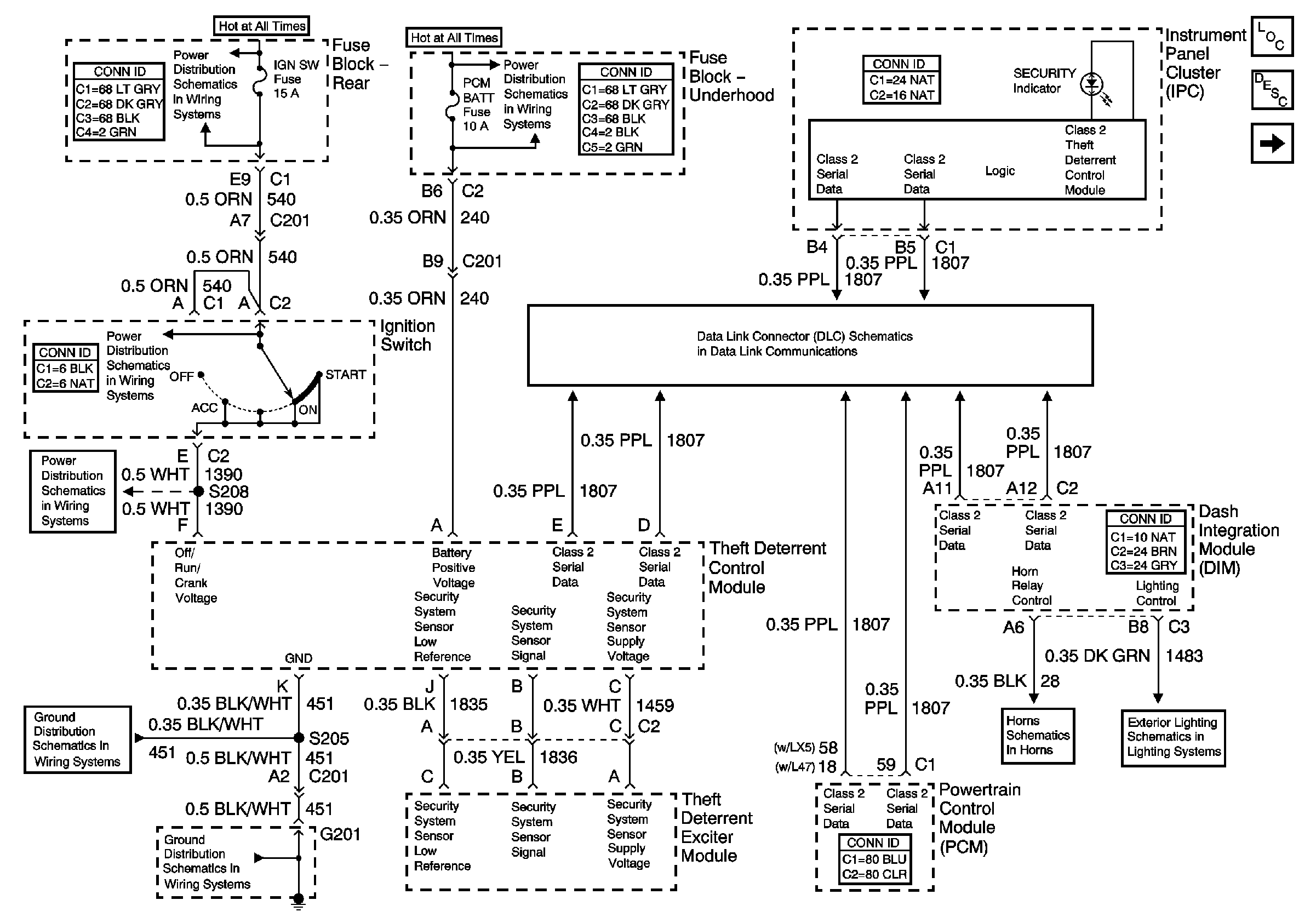Schematic
Refer to
Theft Deterrent Control Module

schematic
Circuit Description
When an ignition key is inserted into the ignition lock cylinder, the transponder embedded in the head of the key is energized by the exciter coils surrounding the ignition lock cylinder. The energized transponder transmits a signal that contains its unique value, which is received by the theft deterrent controller module . The theft deterrent controller module then compares this value to a value stored in memory (learned key code). If the value is correct the theft deterrent controller module sends the enable password via the class 2 serial data circuit to the PCM.
Conditions for Running the DTC
The ignition switch must be in RUN. The theft deterrent controller module cannot have a current DTC B1327.
Conditions for Setting the DTC
The theft deterrent controller module is unable to measure the ignition key transponder value for one second. This may be due to a damaged or missing transponder pellet, a non Pass Key III® key, or a damaged exciter. If the conditions occur after the engine is running, setting the DTC may take up to 30 seconds. See Important below.
Action Taken When the DTC Sets
- The theft deterrent controller module sends a class 2 message containing a disable password to the PCM.
- The vehicle will not start.
- The theft deterrent controller module sends a class 2 message to the instrument cluster to illuminate the SECURITY indicator on steady.
Important: If the theft deterrent controller module is unable to measure the ignition key transponder value for 30 consecutive seconds, after the vehicle has started, the module will enter a fail enable state. The vehicle will not stall or stop running. If the theft deterrent controller moduleis in a fail enable state when the ignition is turned to OFF, it will remain "fail enabled" until the next time the vehicle is started. If the theft deterrent controller module is "fail enabled" the Pass Key III® system is NOT active and the vehicle will start. The controller module WILL send its enable password even if a transponder value is not received. The theft deterrent controller module will remain "fail enabled" until it measures a valid key transponder value. the valid key measurement is done every 300 milliseconds.
Conditions for Clearing the MIL/DTC
The theft deterrent controller module clears the current status of the DTC when it senses a key code from the exciter module . If the code is not from a learned key, a DTC B2960 will be set.
Test Description
The numbers below refer to the step numbers on the diagnostic table:
-
The key must be a Pass Key III® transponder key with an operating transponder for the system to work.
-
The only method to confirm whether the transponder in the key or the theft deterrent controller module is malfunctioning is to try a alternative component in the system. The vehicle was delivered with four keys.
-
It is unlikely that more than one key will be defective. If all keys do not work, the theft deterrent controller module must be malfunctioning.
-
If the vehicle has a malfunctioning theft deterrent controller module that malfunctioned during an ignition cycle, the system will be "fail enabled" and the vehicle will start for all keys. In this case the code B3055 will remain set and be current for all keys.
-
If a new key must be tried, it must have the proper mechanical cut and the theft deterrent controller module must "learn" the transponder value.
-
If only one key was available for the vehicle and the replacement key does not work, the theft deterrent controller module must be malfunctioning.
Step | Action | Yes | No |
|---|---|---|---|
1 | Did you perform A Diagnostic System Check - Theft Deterrent System? | Go to Step 2 | |
Inspect the vehicle's key for damage to the molded head and for PK3 embossed on the shank. Is the head of the key damaged or missing the PK3 embossing? | Go to Step 7 | Go to Step 3 | |
Are more than one of the vehicle's keys available? | Go to Step 4 | Go to Step 7 | |
Do any of the available keys start the vehicle? | Go to Step 5 | Go to Step 9 | |
Do all of the available keys cause DTC B3055 to set? | Go to Step 9 | Go to Step 6 | |
6 | Do any of the available keys cause DTC B3055 to set? | Go to Step 7 | Go to Diagnostic Aids |
Is the replacement complete? | Go to Step 8 | - | |
Does the replacement key cause DTC B3055 to set? | Go to Step 9 | Go to Step 10 | |
9 | Replace the theft deterrent controller module. Perform the theft deterrent controller module learn procedure. Refer to Programming Replacement Keys, Ignition Cylinder, or Powertrain Control Module . Is the replacement complete? | Go to Step 10 | - |
10 |
Important: If a 10 Minute or 30 Minute Re-Learn procedure was performed, all keys not learned at that time have been erased and will not be recognized. Perform the quick learn procedure or instruct the customer on how to perform the quick learn procedure. Refer to Programming Replacement Keys, Ignition Cylinder, or Powertrain Control Module .
Does the DTC reset? | Go to Step 2 | System OK |
